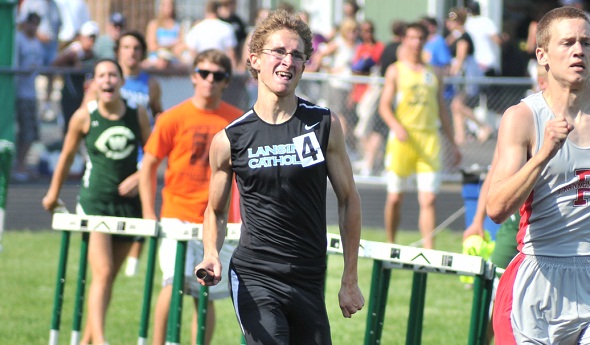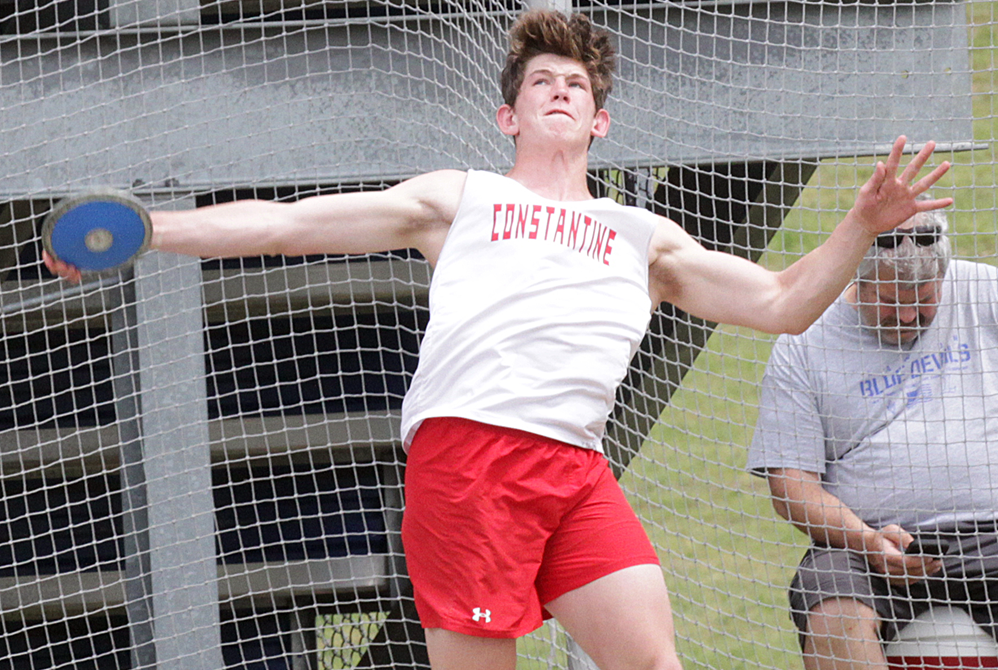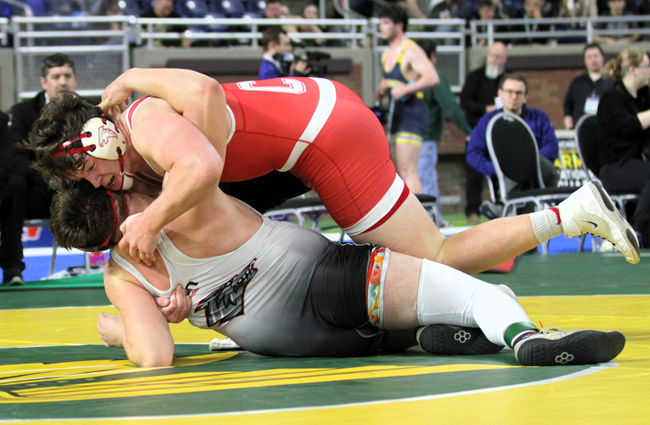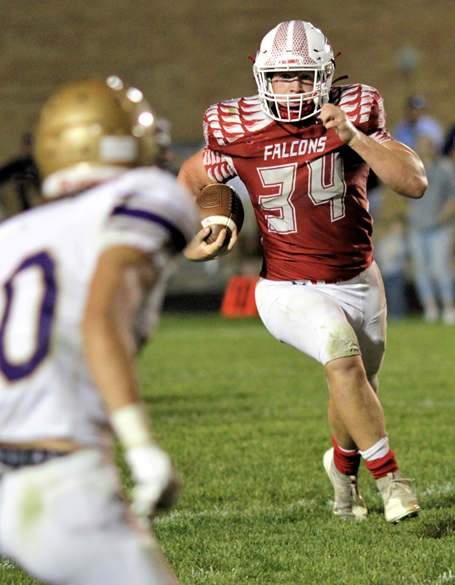
Zingsheim's Story an Award-Winner
May 31, 2012
By Geoff Kimmerly
Second Half editor
Zack Zingsheim’s career highlight is an easy pick.
It was just a few months ago, at Michigan International Speedway, when he stunned even himself by winning the MHSAA Division 3 cross country championship.
He can describe in vivid detail being the last to come out of the chute at the finish, looking into the grandstand and telling himself to always remember the moment. He can see again his teammates further down the chute, chanting his name. The goose bumps he felt. How they jumped the fence, lifted him to their shoulders and carried him off the course.
It was the greatest day he could remember. And it ended with a pie in the face.
“I remember how surreal the moment was,” he said. “Since I was a little kid, I thought it would be so cool to win the state meet for cross country; the atmosphere is so amazing.”
Nearly as amazing is he doesn’t remember the flavor of the pie.
Zingsheim tells a story with the best of them – thanks in part to a keen photographic memory and attention to detail.
But he gets a Second Half High 5 this week because of his status as one of the state’s top high school runners – and what a tale he’s spun over the last year.
Zingsheim has the top-seeded Division 3 time in the 800 meters (1:55.30) heading into Saturday’s Finals at Comstock High School, and also runs on the top-seeded 800, 1,600 and 3,200 relays. He and his teammates won the 800 relay at last season’s Finals, and he has or is part of school records in all four of those races, plus the 400. He’s also the fastest in Cougars cross country history.
Another of his favorite stories to tell explains why.
Diamond in the rough
He remembers seeing the Corunna baseball diamond in the distance. That’s key to this story.
Zingsheim was a freshman in 2009, running the second leg of the 800 relay, and had just taken the baton. His right hip had been feeling tight and then painful over the previous couple of weeks, but he felt great at that point as he glanced ahead and saw the baseball field.
The next step, he felt like he got hit with a baseball square in the right hip. But there was no baseball.
He tried to bring the leg forward, and couldn’t. He dragged his leg the next 100 meters to complete his handoff, and then collapsed.
Zingsheim did see a “flabby piece of bone just laying there.” He started crying. His parents immediately drove him to the hospital as he screamed the lyrics to whatever was on the radio to try to forget the pain. (And yes, he remembered one off the songs: “Boom Boom Pow” by the Black Eyed Peas.)
The flexor muscle that connected his hamstring to his pelvis had torn and taken the top of that part of his pelvic bone with it.
Next came months of therapy and changes. He’d started on the freshman basketball team, but decided to stop that sport and focus on running. Still, he couldn’t get in shape that summer because he couldn’t put in the miles, and his sophomore cross country season wasn’t what he’d wanted – until he ran a personal best late in the season and got a needed confidence boost.
“There’s something so special about being able to run so hard and seeing hard work come to fruition on the course or the track,” Zingsheim said. “And especially, seeing how far I had to come. I wanted to see what kind of runner I could become if I put all that work in.”
His 1,600 relay finished eighth at the 2010 Division 3 Finals, another turning point. A year later, Lansing Catholic coach Tim Simpson needed a fill-in on the 800 relay. The date was April 13, 2011 – a day shy of two years since he’d suffered the pelvic break. “I’ve never been so nervous for another race,” he said. But the Cougars set a school record, and he’s been on that relay since.
A long road traveled
“He’s come a long way, but he’s always had that ability,” Simpson said. “He ran 50-70 miles a week during the summer. He reads about the top runners, follows it, so he know what they’re doing, what you’re supposed to do if you’re going to be good.”
There’s always an eye on the details; Zingsheim’s got a reputation among his classmates as the guy who always is last to turn in his tests. He gets done quickly, but spends the rest of the period double and triple-checking his answers to make sure everything is right.
There are plenty of other stories, of course. Like how he and his talented classmates – Lansing Catholic’s senior boys also played in the Division 5 Football Final in the fall – split up during middle school into football teams that stayed the same for months and turned into fierce rivalries. (He played receiver.)
He’s earned the story-teller role in his family too; at gatherings he’s often the go-to guy for a “quirky” or “goofy” family tale.
But the stories he’ll be most proud to be part of are those that get passed down to Lansing Catholic runners after him.
Zingsheim was in first grade when his brother Brandon was a senior on the cross country and track teams and began the Cougars’ tradition of saying a “Hail Mary” and chanting “Hey Cougars, what we going to do?” Zack is among those who now lead that rally.
Lansing Catholic had outstanding runners before Zingsheim. But with him and a strong group of individuals including distance seniors Jimmy Hicks (who will walk-on at the University of Georgia), Austin Winter and Joe Marrah, they could cap their careers with the team’s first MHSAA championship.
“What I really wanted to do by the time my tenure was done was lay a foundation. Build the program; do things the right way,” Zingsheim said. “I wanted to teach guys what it means to be an LCC runner.
“The last four years, we’ve really been able to build that program. … And I’m so excited to see where the program is going the next couple of years.”
Click to read more about Zingsheim's inspirations and aspirations.
PHOTO: Lansing Catholic's Zack Zingsheim was part of the championship-winning 800 relay at last season's Division 3 Final.

Constantine Football All-Stater, Wrestling Champ Aiming for Grand Finale
By
Scott Hassinger
Special for MHSAA.com
April 30, 2024
CONSTANTINE – Bennett VandenBerg has earned many accolades over the last four years as a three-sport athlete at Constantine.
 But the awards aren't what the 6-foot-3, 240-pound standout will remember most when reflecting on his memories as an all-state football player, state champion wrestler and record-breaking throwing specialist on the Falcons' track & field squad.
But the awards aren't what the 6-foot-3, 240-pound standout will remember most when reflecting on his memories as an all-state football player, state champion wrestler and record-breaking throwing specialist on the Falcons' track & field squad.
"I'll remember how I represented our school and pushed myself to be the best I could be in each sport that I played," said VandenBerg, who has earned 12 varsity letters.
VandenBerg has evolved into one of the most accomplished athletes in the state this school year as a senior, especially standing out among those from smaller communities.
This past fall he was named first-team Division 5-6 all-state at defensive end in football before winning the Division 3 Individual Finals wrestling title at 285 pounds in early March at Ford Field.
VandenBerg's final goal is to win the discus title at the Lower Peninsula Division 3 Finals on Saturday, June 1, in Kent City to end his Constantine career all-state in all three sports.
He broke the school record in the discus his junior year with a throw of 158 feet, 1 inch; the previous mark of 156-6 had been held by Doug Polasek since 1986. VandenBerg has eclipsed his school record twice this spring, most recently with a personal-best toss of 170-9 in a Southwestern Athletic Conference double dual meet with Schoolcraft and Kalamazoo Christian. He ranks No. 4 statewide in the event regardless of enrollment division. Lawton junior Mason Mayne at 175-4 is the only Division 3 competitor with a better throw than VandenBerg.
"It's really cool to have your name up on the school record board, but I'd like to make that mark more untouchable before I'm done," VandenBerg said. "My goal is to be a state discus champion. I've put in the necessary work for it. It would be nice to end my career that way."
Kyle Rimer, Constantine's veteran boys track & field coach, is most impressed with VandenBerg's leadership and presence in working with the Falcons' younger athletes.
 "Bennett loves to compete. Ever since he was a freshman, we've also had him on our 400-meter relay team. That's something he really enjoys doing. He's not just a thrower, but a good overall athlete with lots of drive,” Rimer said. “There's a lot of individuality in track & field, but I think he does a great job of leading the younger kids. He has the drive, accountability and technique to achieve his goal of being a state champion in his throwing events.”
"Bennett loves to compete. Ever since he was a freshman, we've also had him on our 400-meter relay team. That's something he really enjoys doing. He's not just a thrower, but a good overall athlete with lots of drive,” Rimer said. “There's a lot of individuality in track & field, but I think he does a great job of leading the younger kids. He has the drive, accountability and technique to achieve his goal of being a state champion in his throwing events.”
VandenBerg is already a two-time Finals placer in the discus, earning sixth as a junior and seventh his sophomore year. He admits being a little disappointed with his distance at the 2023 state meet.
"In that particular event (discus) you need lots of focus and determination because there are a ton of tiny things you can mess up on that affect your throw. To become better you need to be consistent, show up every day and be willing to put in the work," VandenBerg said. "Right now I'm working on my speed in the circle and quickness in my follow-through."
VandenBerg also has been pleased with his improvement this spring in the shot put. He's increased his distance by over five feet and hopes to break the school record in that event as well. John Kampars (1967) holds Constantine's shot put record at 54-8¼, and VandenBerg's personal best is 48-10 in a double-dual meet this season against Parchment and Centreville.
"Shot put is a difficult event. You need power, but your form has to be top-notch – otherwise it's tough to move that 12-pound ball," VandenBerg said. "I would love to qualify for state in both the discus and shot put and be all-state in each. That would be amazing if I could be a state champion in either of those events."
VandenBerg has put in extra work in the offseason with special instruction from Bill Griffey of Next Throw in Plainwell, along with working with Constantine assistant track & field and head football coach Shawn Griffith.
"Bennett puts a lot of time into working on his throwing. He spends a lot of time in the weight room, and he's a bigger kid who is not afraid to be coached and listens to what other people tell him," Griffith said. "We're excited to see what he can do now that we've had warmer weather recently."
 VandenBerg's motivation this spring follows a tremendous wrestling season that saw him finish 54-0 and capture the 285 championship with a 3-0 win in the title match over Reed City junior Wyatt Spalo.
VandenBerg's motivation this spring follows a tremendous wrestling season that saw him finish 54-0 and capture the 285 championship with a 3-0 win in the title match over Reed City junior Wyatt Spalo.
"I gained 20 pounds of muscle and did everything you need to do to become a better athlete to wrestle the heavyweight division. Winning the title was overwhelming. It was everything I ever wanted, and the first 20 minutes after winning it was relief, especially after losing in the Finals as a junior. I just went into that last match and wrestled smart and confident," VandenBerg said. "My speed and strength gave me an advantage over the bigger heavyweights I faced this year."
Vandenberg, 188-22 with 104 career pins, became the 10th Finals champion in Constantine wrestling history and the first to achieve the feat since Kevin Watkins won a 152-pound crown in 2000.
VandenBerg competed at 189 as a freshman and sophomore. He was a Regional qualifier as a freshman and finished sixth in Division 3 as a sophomore before ending his junior campaign as the Finals runner-up at 215.
"Bennett is a competitor who hates to lose, and if he does he learns from it. He had a lot of good practice partners on the team his first three years, and he wasn't going to be denied after losing in the Finals as a junior," said Constantine wrestling coach Dale Davidhizar Jr.
VandenBerg played on Constantine's varsity football team for four years. He got a lot of extra playing time as a freshman when Constantine reached the Division 6 Semifinals during in the COVID-shortened season. He led the Falcons in rushing as a sophomore before switching to tight end as a junior. Out of necessity, VandenBerg returned to lead Constantine in rushing and scoring again as a senior.
"Bennett learned a great deal from the older guys on the team his first three varsity seasons. He learned leadership qualities and is a very unselfish kid who is willing to do what's best for his team," Griffith said.
VandenBerg is most proud of Constantine winning a District crown last fall, especially after his senior class went 0-5-1 as eighth graders. VandenBerg posted 164 solo tackles at defensive end during his final high school season and was Constantine's main offensive weapon with 1,354 yards and 16 touchdowns rushing on 186 carries.
"Winning Districts as seniors in football was a special moment. As eighth graders, we weren't exactly the most athletic team, but we put in the work as we got older to become successful," VandenBerg said.
VandenBerg has been invited to play for the West team at the annual Michigan High School Football Coaches Association's East-West All-Star Game this summer.
College coaches have shown interest in VandenBerg in all three sports, especially football and wrestling. VandenBerg, who carries a cumulative GPA of 3.989 and scored 1110 on his SAT, is weighing his options in athletics but knows he wants to study either ecology or forestry in college.
"I love being outdoors and doing what I love to do," VandenBerg said.
 Scott Hassinger is a contributing sportswriter for Leader Publications and previously served as the sports editor for the Three Rivers Commercial-News from 1994-2022. He can be reached at [email protected] with story ideas for Berrien, Cass, St. Joseph and Branch counties.
Scott Hassinger is a contributing sportswriter for Leader Publications and previously served as the sports editor for the Three Rivers Commercial-News from 1994-2022. He can be reached at [email protected] with story ideas for Berrien, Cass, St. Joseph and Branch counties.
PHOTOS (Top) Constantine’s Bennett VandenBerg competes in the discus during a home meet his junior season. (Middle) VandenBerg, top position, battles Wyatt Spalo in their Division championship wrestling match at 285 pounds in March at Ford Field. (Below) VandenBerg (34) carries the football during a 2023 regular-season home game against Schoolcraft. (Photos by Brandon Watson/Sturgis Journal.)

